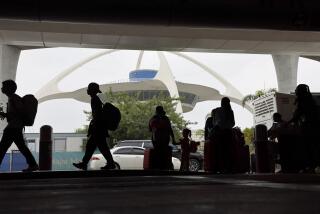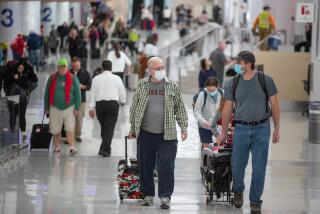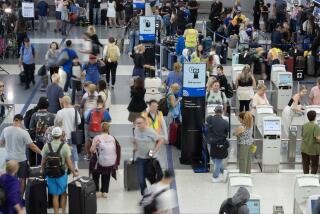Sandy continues to hamper nationwide air travel
As the number of canceled flights continued to mount in Cyclone Sandy’s wake, analysts said the key to reopening storm-battered airports and getting flights back on schedule was to repair surface transportation so airport crews can staff their posts.
Super storm Sandy was blamed for cancellations of as many as 18,100 flights from Saturday through Wednesday and closing airports in East Coast cities including New York, Philadelphia and Newark, N.J. Some airlines have already begun to cancel a few dozen flights scheduled for Thursday.
The storm ripped through the nation’s busiest airspace, and the effects have rippled across the country. At Los Angeles International Airport, more than 100 incoming and departing flights were canceled Tuesday, according to the travel monitoring site Flightstats.com.
STATE BY STATE: Snow piles up; beaches wash away
The storm, now categorized as a cyclone, caused flood damage at LaGuardia International Airport and John F. Kennedy International in New York and Newark Liberty International Airport and Teterboro Airport in New Jersey. But Sandy largely spared other airports, including Washington Dulles International Airport and Ronald Reagan Washington National Airport.
Even if flood damage is repaired quickly, experts say some airports could stay closed as long as airport employees are kept from reporting to work because of limited service on trains, subways and buses. Transportation officials on the East Coast said they could not estimate when their public transit systems would be back to full service.
“The bigger thing is getting public transportation systems going to get workers to the airport,” said Sean Broderick, a spokesman for the American Assn. of Airport Executives, a trade group for the operators of 850 airports across the country. “With no public transportation, that is a bigger hang-up.”
VIDEOS: East Coast hit by deadly storm
The Port Authority of New York and New Jersey announced Tuesday that the elevated rail systems to JFK and Newark airports were closed and public bus service was suspended in some areas. Several tunnels that serve New York’s subway system were flooded and could remain closed indefinitely, New York officials said.
The Metropolitan Washington Airport Authority, which runs Dulles and Ronald Reagan airports, said those airports “weathered Hurricane Sandy without damage or flooding.” Still, the authority permitted only a limited number of flights at the two airports Tuesday, saying normal operations were not expected until Wednesday.
Fewer travelers have been stranded at airports, partly because the storm was anticipated for days, giving airlines time to cancel flights and notify passengers to stay home.
“This wasn’t a sneak attack,” said George Hobica, founder of the travel site Airfarewatchdog.com. “Every computer model said this was going to happen.”
In contrast, the ice storms that struck huge swaths of the country in January and February 2011 left thousands of travelers stuck at airports as the storm caught airlines off guard, with little time to warn passengers before canceling flights.
Airlines are also being careful not to keep passengers stranded on planes since the U.S. Department of Transportation adopted heavy fines in 2010 for carriers that leave aircraft sitting on the tarmac for more than three hours without giving fliers the option to return to the terminal. The airlines face a fine of up to $27,500 per passenger.
Rick Seaney, a travel expert with the travel site Farecompare.com, pointed out that the storm struck at a slow period for the travel industry, before the major holiday travel season kicks off.
Still, he said the effects of the storm could last for days, as besieged airlines work to refund or rebook the tickets of hundreds of thousands of passengers whose flights were canceled.
Barring any further glitch at East Coast airports, Seaney said he expects the nation’s airline system to be back on schedule by next week.
“It’s going to take a few days to get people back to work,” he said. “I think we could be good to go by Monday.”
More to Read
Sign up for Essential California
The most important California stories and recommendations in your inbox every morning.
You may occasionally receive promotional content from the Los Angeles Times.










